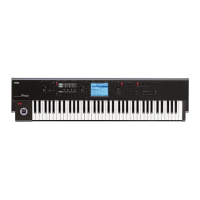Playing and editing Combinations
48
Layers, Splits, and Velocity
Switches
Within a Combination, you can use note range and
velocity level to define the “zone” in which a specific
timbre will play.
The Programs assigned to each Timbre can be played
in three ways: as part of a layer, a split, or a velocity
switch. A Combination can be set to use any one of
these methods or to use two or more of these methods
simultaneously.
Layer
Layers cause two or more Programs to play
simultaneously when a note is played.
Split
Splits cause different Programs to respond on different
areas of the keyboard.
Velocity Switch
Velocity Switches cause different Programs to respond
depending on the velocity (how hard you play the
notes).
On the M50, you can use a different Program for each
of up to sixteen Timbres, and combine two or more of
the above methods to create even more complex
setups.
As an additional possibility, you can set the slope for a
key zone or velocity zone so that the volume
diminishes gradually. This lets you change a split into
a keyboard crossfade, or a velocity switch into a
velocity crossfade.
Creating Key Splits and Layers
Splits and Layers
Let’s create a Combination which combines both splits
and layers, like the diagram below:
1. Access the Combi P0: Play– Program T01–08 page.
2. Select a piano sound for Timbre 1, a brass sound
for Timbre 2, and a strings sound for Timbre 3.
3. Access the P3: Timbre Param– MIDI T01–08 page.
4. For Timbres 1–3, set Status to INT and MIDI
Channel to Gch (the Global Channel).
5. Access the P4: Zone/Delay– Key Z T01–08 page.
6. Set Timbre 1’s Top Key to G9, and its Bottom Key
to C4.
You can also enter a note value by selecting the
parameter and then playing the desired note on the
keyboard while holding down the ENTER switch.
7. Set Timbres 2 and 3 to a Top Key of B3, and a
Bottom Key of C–1.
Key Zone Slope
In addition to “hard” splits, in which the sound
changes abruptly, you can use the Slope parameters to
gradually fade a sound in or out over a range of keys.
In the example above, you could set the Bottom Key of
timbre 1 to G3, and set the Top Key of timbre 2 to G4,
so that these two timbres overlap.
Next, if you set the Bottom Slope of timbre 1 to 12, and
set the Top Slope of timbre 2 to 12, the sound will
change gradually instead of changing suddenly.
Program B
Program A
Layer:
Two or more programs sound
simultaneously.
Program B
Program A
Split:
Different programs will sound in
different areas of the keyboard.
Program A
Program B
Keyboard playing
dynamics
Strong
Soft
Velocity Switch:
Keyboard playing dynamics
(velocity) switches between
different programs.
Program C
Program D
Program B
Program A
Keyboard playing
dynamics
Strong
Soft
Example:
B and C/D are split. In the lower
keyboard range, A and B are
layered. In the higher keyboard
range, C and D are switched by
velocity and layered with A.
Program A
Program B
Keyboard X-Fade (keyboard
crossfade):
As you play from low notes to
high notes, the volume of A
will fade out, and the volume
of B will fade in.
C–1 C4 G9B3
PianoTimbre 1
Brass
Timbre 2
Strings
Timbre 3

